Content

Today, many are trying to grow champignons on peat, but in order for the work to be useful, you need to know some subtleties.
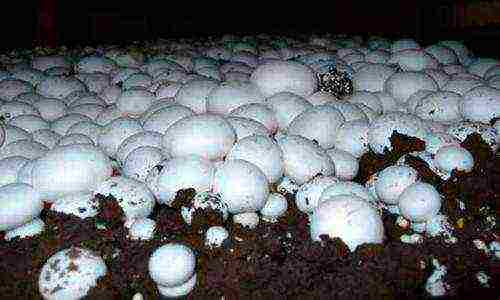
Compost for growing mushrooms can be made from cow dung.
Tools and materials
- compost;
- insulation;
- economic fan;
- mycelium;
- cement;
- sand;
- shovel;
- snail fan;
- pasteurization chamber;
- tena;
- peat structurizer;
- foam boards.
Back to the table of contents
Features of the arrangement of the premises
The cultivation of mushrooms on peat can be carried out by equipping, for example, a barn or a former cowshed.
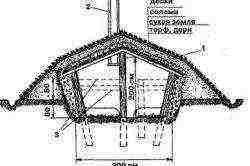
Arrangement of the premises for growing mushrooms: 1 - the roof of the dugout; 2 - ventilation pipe; 3 - racks for growing mushrooms.
In order for the grown mushrooms to be sold, expecting a good profit, it is recommended to use a room that has an area of approximately 1800 sq. m. The premises must be supplied with electricity and water.
Champignons on peat will grow well if the room is airtight, for this you should insulate the gates, install windows, insulating them. Thus, you will get a kind of workshop designed for growing mushrooms.
Compost should be made by wrapping it in bags and placing it on the floor in a mushroom maker. The room must be equipped with a 30 kW fan. You can use a fan, which is used for drying grain on the farm - it will "draw" fresh air into the inner space, providing circulation.
Compost can be made from cow dung by placing heaps of manure on a concrete platform under the sky, they should be interrupted three times, which must be done at intervals of three days, "pasteurization" also needs to be done in the open air in heaps.
The compost obtained for growing mushrooms on peat should be packed in 15 kg bags, arranging the bags in rows in the mushroom bowl. The mycelium should be sown into bags, piercing the funnels with reinforcing pegs, 1200 kg of mycelium will be needed. Backfilling with peat should be done after a couple of weeks, then you need to water it, etc. "Cold shock".

The scheme for preparing compost for mushrooms.
Champignons on peat can be grown in the same room, which can be divided into oversized mushrooms of 100 m each. Compost can be made using liquid chicken manure, available from the poultry farm. The compost should contain fresh wheat straw. Watering should be done not by drip, but by pollen.
It is important to pay attention to ventilation, humidity and temperatures when growing mushrooms on peat. The cause of a crop failure can be “under-disinfection”. Cultivation of mushrooms is often unsuccessful due to the use of improperly prepared compost.
It is preferable to purchase it from professionals, but if you decide to cook it yourself, then you need to use a pasteurization chamber, otherwise the champignon maker itself can be prepared appropriately so that the compost can be pasteurized indoors. If a heat chamber is used, then it must meet all the requirements necessary to comply with pasteurization processes.
The cover-peat mixture is used exclusively in conjunction with compost. Covering mixture is an extremely loose substrate, for this reason it is able to retain a lot of water, creating the most optimal air regime for the mushroom.The mixture contains 30% lowland peat, 70% transitional peat, the Ph level can vary from 7.4 to 7.6. The mixture is deoxidized with fluff lime.
Champignons on peat will grow only when compost has been additionally used. You can dig a hole for its preparation by concreting it. Next, it is necessary to equip the slatted floor, which will provide ventilation and recirculation. A ventilation room must be equipped on the side, in which a snail fan must be installed. Behind the fan, from the bottom, you should install heating elements that will be responsible for heating the air. The roof should be made of foam boards.
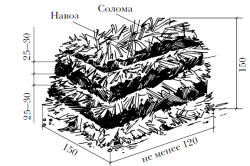
The scheme of preparing the beds for growing champignons.
A 40-ton container, which is used in transportation, is perfect for the pasteurization chamber. After the walls of the container are insulated, it is possible to equip a slatted floor, or replace such an option by installing the container on a foundation, providing a slatted floor. A ventilation chamber should be placed on the side.
Growing mushrooms on peat will bear fruit if you compost correctly. So, it is necessary to use high-quality raw materials when preparing compost - if horse manure is used, it is important what the horses are fed with, what kind of bedding is used. When preparing synthetic compost on chicken manure, it is also important to comply with these conditions.
The cultivation of champignons on peat will be correct if peat is used as a casing mixture; for peat, it is preferable to use a structurant. If you decide that growing mushrooms will be accompanied by self-composting, then you will need to purchase a shredder for chicken manure. It is important not only what kind of fertilizer will be used, but also how well the room will be disinfected; for this, a mist sprayer should be used, which will be responsible for increasing humidity and cooling.
Back to the table of contents
Alternative options for mushrooms on peat
It is not recommended to grow mushrooms on peat in the basements of residential buildings, since ammonia will be released during the cultivation process. For amateur mushroom growing, you can use champignon mushrooms, which are of a semi-basement type. In them, the stove will perfectly cope with heating. You can use one of several types of mushrooms, including: Moscow, St. Petersburg, as well as a greenhouse designed by the entrepreneur Grachev.
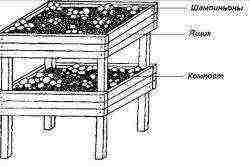
The scheme for growing mushrooms in boxes.
In order to equip the St. Petersburg champignon house, you need to prepare a pit, the depth of which is about 70 cm. The walls in it should be laid out with bricks. You can make them wooden, but in this case it will be necessary to use the cheapest wood, since the wood will have to be changed annually, due to high humidity. The roof of such a room is made gable. Previously, horse manure was laid on such a roof, the layer of which could reach 30 cm, this provided insulation for the greenhouse. Today it is customary to use cattle manure or simply cover the roof with earth. For the winter, such a mushroom can be covered with straw. The room will turn out to be warm enough and will need additional heating only in severe frosts.
The middle of the mushroom box should be equipped with a passage, the width of which can be up to 1 m. The boxes that will be used for pasturing mushrooms grown on peat should be placed along the walls. Ventilation vents should be made in the roof, expecting that their number should be 1 per 6 running meters of the roof. Mushrooms, which are grown on peat, do not need lighting, which leads to the absence of windows in this mushroom.
Champignonnitsa Gracheva has another name - a seven-rack greenhouse.It differs from the above-described design only in the scheme according to which racks for growing mushrooms on peat are located in it.
Champignonnitsa Moscow got its name due to the fact that the design is extremely often used by Moscow gardeners. This champignon maker uses oven heating.
Back to the table of contents
Industrial champignon maker for growing mushrooms on peat
Modern mushrooms, which are intended for industrial cultivation, can be divided into 2 types, the first of them is ground, the second is underground, the last species, in turn, is divided into a couple of subspecies - single-zone and multi-zone. Terrestrial mushroom growing is widespread in Holland.
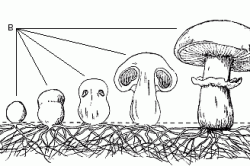
Champignon formation scheme.
A single-zone system for growing mushrooms on peat involves the use of one room, in which the entire growing cycle takes place - from composting to mushroom pasture. The multi-zone scheme is characterized by the use of different rooms, each of which is used separately for composting, incubation and pasturing of mushrooms.
If you decide to equip the last type of room, then you should work on the compost room, where the compost will be prepared, further pasteurized, and also cut. Here, the compost is supposed to be laid out in containers, into which the mycelium must then be introduced. Then the containers should be transferred to the room in which the mycelium grows, where the temperature should be maintained at about 22-25 ° C. After the containers should be transferred to the premises where the fruit bodies are driven out. They must maintain the optimum temperature for the growth of mushrooms - 14 ° C and a high degree of humidity.
Underground mushroom growing on peat can be used if you have at your disposal caves, mines, bomb shelters and other suitable premises or structures. The device of such mushrooms will not fundamentally differ from ground complexes. In underground mushrooms, as well as in ground ones, a single-zone or multi-zone scheme for growing mushrooms on peat can be applied.
Champignon and all saprophytic mushrooms feed on ready-made organic and mineral substances, which, with the help of the mycelium located underground, it extracts from semi-decomposed plant and animal remains. The fruiting body of the champignon, which we eat, is a reproductive organ, since the spores of the fungus are formed here - as it were, its seeds, and from them, under favorable conditions, multicellular filaments germinate - hyphae, which create mycelium in the soil. This is how a closed cycle of fungus development turns out: spore - mycelium - fruit body - spore.
However, champignon also has the ability of vegetative reproduction - from pieces of pre-expressed planting material - mycelium. This very important property is just used in mushroom growing, since in practice they usually resort to vegetative - more reliable and productive - reproduction.
Mass production of champignons is a well-established and well-established process. they can be bred not only in well-equipped industrial mushrooms, but also amateurishly - in homemade mushroom, basements of houses, or even just in the beds.
Many people naively believe that it is enough to sow a ridge of cow dung in open ground without any cover, or even just scatter mycelium in a raspberry grove and champignons will begin to bear fruit from year to year. They believe and do so. Disappointment soon sets in, and the enthusiasts of these mushrooms turn into their opponents.
Is champignon culture beneficial? From 100 kg of straw and 100 kg of poultry manure, compost can be made for growing these mushrooms on an area of 3 m2. Their total collection per turn will be 45 kg.
Cultivating champignons, mushroom growers get the opportunity to use the heat generated by the overheating compost with a temperature of 45-60 ° C for 25-30 days for growing flower or tomato seedlings at the end of April and in May. After harvesting, the compost can be used for fertilization.
Champignons are a high-yielding culture. even with one turnover, mushroom picking will be 3-4 times higher than picking vegetables from the same area. Besides. mushrooms do not require a “place in the sun” - they grow without light. A strip of land adjacent to the northern side of the building is allocated for these mushrooms.
Rice. Semi-basement and shelters for growing mushrooms (dimensions are in cm):
a - the internal structure of the semi-basement (1 - wooden fasteners; 2 - overlapping from a plank; 3 - a layer of insulation; 4 - a layer of soil; 5 - an exhaust pipe; 6 - a damper);
b - shelter of ridges laid on the surface (1 - frame covered with tar paper or film; 2 - ridge; 3 - frame);
c - shelter of ridges laid in a trench (1 - groove for water drain; 2 - asbestos-cement slab; 3 - timber; 4- bricks; 5 - substrate)
At different stages of their development, champignons need different growing conditions. After planting the mycelium in the ground (compost), no watering of the ridge during the entire time (about a month) of the growth of the mycelium is inadmissible. During this period, only protection of the surface of the ridge from drying out and high air humidity (90 - 95%) is required. Any penetration of water into the compost. even in small quantities, it will almost inevitably lead to rotting of the compost and the complete or partial death of the mycelium. The optimum temperature in the ridge for the good development of the mycelium is 25 - 27 ° С, at temperatures above 32 ° С it dies. The carbon dioxide released by the compost does not need to be removed from the mushroom - it is necessary for the growth of the mycelium.
During the fruiting period, the optimal conditions for a good harvest are different: after the mycelium, growing, begins to emerge on the surface of the compost, a layer of a mixture called casing layer is laid on the ridge and watered so that it becomes moist, but not wet. In the future, during the entire period of fruiting, this moisture content of the casing layer must be systematically maintained, otherwise fruiting will not be complete - after all, mushrooms are 90% water. At the same time, the requirement remains that an excess of water does not form, which could seep through the casing layer into the compost to the mycelium, from which the mycelium will die. “It is better to underfill than to pour,” mushroom growers say. The air humidity is maintained high, not lower than 80%. The air temperature above the bed should be reduced to 15-17 ° C.
The air above the ridge during the entire fruiting period should be clean, free of carbon dioxide impurities by natural or forced ventilation. But at the same time, not the slightest draft, rapid movement of air directly above the surface of the ridge should be allowed.
There is also a requirement for mushroom culture common to all phases of development. Temperature, humidity, optimal for the growth of mycelium or fruiting, should be constant.
Requirements for the regime in the champignonnice seem paradoxical. a lot of water on the ridge - and not a drop in the compost: vigorous air refreshing without moving it directly above the ridge: high (25 - 27 ° С) growth temperature of mycelium - and its decrease to 15 - 17 ° С from the moment of fruiting. However, such requirements are dictated by experience.
Of course, it is advisable to get mushrooms in the garden as early as possible, at least at the end of May. But for this, the mycelium must ripen from mid-April, when the average daily air temperature is still not high enough. During this period, natural heat is not enough, but during the fruiting period, when the optimal temperature for the mushroom ridge should not be higher than 17 ° C, the outside air is usually too hot.
All these difficulties can be overcome. The mushroom growers' ally in this is the mushrooms themselves.
Fried, salted, baked, in salads - in any form
champignons
are always appropriate on the festive table. We are used to seeing these mushrooms on store shelves, but it is quite possible to grow them with our own hands at home.
Preparation of horse manure substrate
In the warm season, champignons can be grown in the beds, but in the fall and winter this will require a special indoor area. At home, such a room can be a warm barn, basement, greenhouse, greenhouse. It should have a temperature in the range of + 12-18 ° C and a humidity of about 65-85%.
Mushrooms grow best in fresh horse manure with straw bedding. You can also add cow dung and rye straw. If it is not possible to purchase horse manure, GreenColor recommends replacing it with chicken or pork manure, and instead of straw, use fallen, rotten leaves and rotten straw. Corn stalks are also beneficial. Do not use rotten straw and rotted manure. Light is not needed for mushroom breeding. They bear great fruit and grow in the dark.
If you are using horse manure and litter substrate, first place it in a cone-shaped pile, and pour water or diluted manure on top. Keep an eye on the humidity, it should reach 70%.
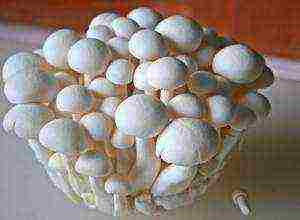 Next, add ammonium sulfate in the ratio - 3 kg per 1 ton of manure. Cover the pile with straw, burlap. This is done so that the water does not evaporate, and the manure warms up. Ammonium sulfate will help develop the activity of bacteria that decompose manure. Leave the substrate in this state for 5 days. Then shake the manure well with a pitchfork to mix, then it will evenly warm up. At the same time, you need to add gypsum in a ratio of 4 kg per 1 ton of manure. Shake the manure every 5 days. In total, manure is infused for 15 days. If you did everything correctly, then by the end of the preparation your substrate will become a dark mass, homogeneous and odorless of ammonia. Try to break the straw, it should give way easily. Now you can start bookmarking.
Next, add ammonium sulfate in the ratio - 3 kg per 1 ton of manure. Cover the pile with straw, burlap. This is done so that the water does not evaporate, and the manure warms up. Ammonium sulfate will help develop the activity of bacteria that decompose manure. Leave the substrate in this state for 5 days. Then shake the manure well with a pitchfork to mix, then it will evenly warm up. At the same time, you need to add gypsum in a ratio of 4 kg per 1 ton of manure. Shake the manure every 5 days. In total, manure is infused for 15 days. If you did everything correctly, then by the end of the preparation your substrate will become a dark mass, homogeneous and odorless of ammonia. Try to break the straw, it should give way easily. Now you can start bookmarking.
Preparing a substrate from chicken manure
To prepare the substrate, you will need 400 kg of chicken manure, 60 kg of gypsum and 25 kg of carbamide for 1 ton of straw.
First of all, mix 150 kg of chicken manure and 25 kg of carbamide (dissolve it in water beforehand). Leave it on for 10 days and during this time spray the entire pile with water. For the entire period, you must pour out 2000 liters of water, and the straw must absorb it. Next, fold the straw into a pile. Do it in layers - a layer of straw, a layer of chicken manure in a ratio of 250 kg per 1 ton of dry straw.
4 days after soaking, you can start shaking up the straw with a pitchfork. And then the whole gypsum is added at once. The second time you need to shake it up on day 8 and the last time on day 11. And 2 weeks after soaking, the substrate is ready and you can start laying.
Ground laying
If you have a closed room, then mushrooms can be grown directly on the floor, on shelves or in wooden boxes. The boxes must be stacked on top of each other.
Bookmark options:
- On the earthen floor, you need to set up ridges. They need to be made in dimensions of 50 × 50 or 75x75 cm. Then they take the prepared manure and put it in the first layer. Thickness - 45 cm. Then they take a rammer and compact it well to 30 cm. A shovel needs to be trimmed from the sides.
- If you are using racks, then manure must be laid on them in a layer of 30 cm. And then compact to level and smooth the surface.
- Planting boxes can be used in different ways. It is most convenient to use those with a length of 100 cm, a width of 50 cm and a height of 23 cm. Now you need to lay the manure and compact it with a manual rammer.
- If you grow outdoors, start laying in the spring as soon as the soil warms up slightly and warms up. Manure must be placed directly on the ground; a shallow trench can be dug. Choose a shaded area, mushrooms do not like the sun.And over the bed, in order to prevent the soil from becoming waterlogged during the rain, you need to make sheds. They will also save the harvest from the direct rays of the sun.
Planting mycelium
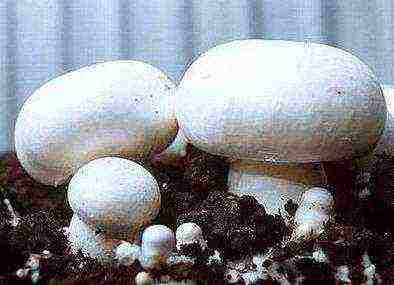 After you have laid the ground, measure its temperature daily. At a depth of 5 cm, it should reach 28 ° C, at which point you can start planting.
After you have laid the ground, measure its temperature daily. At a depth of 5 cm, it should reach 28 ° C, at which point you can start planting.
Use sterile mycelium as planting material. It is grown in special laboratories. The best crop can be harvested from two types of champignons - two-spore brown and two-spore white.
Growing mycelium in the laboratory takes place in wheat, rye or oats, sometimes manure is also used. Mushroom manure is sold in cans, the weight of one is about 1 kg. And grain mycelium is sold in liter bottles.
Before planting, you need to break the dung mycelium, you should get pieces of a walnut, the weight of one is 20 grams. Arrange these pieces in a single layer in a basin so they don't wrinkle. Plant these pieces into the ground in a checkerboard pattern, maintaining a distance of 20 cm.
Plant champignons simply - you need to lift the top layer of soil with a sharp stake, make a small depression and put a piece of mycelium there. Pay attention that the upper edge of the mycelium lies a couple of centimeters lower than the surface of the substrate itself.
If you are using mycelium with grain, then first you need to remove the top of the soil, about 3 cm, and then carefully and evenly scatter the mycelium. And then sprinkle with compost on top and crush slightly.
But you can also use wild mycelium when planting mushrooms. And you need to look for it where mushrooms grow, it can be barnyards, dung heaps, hotbeds, landfills.
Find a place with an abundance of mushroom bodies and dig up the mycelium. Pieces of soil should be permeated with branches of the mycelium, the aroma should be mushroom, and the earth itself should be free of pests and diseases. You need to plant wild mycelium in the same way as a laboratory one.
Mushroom care
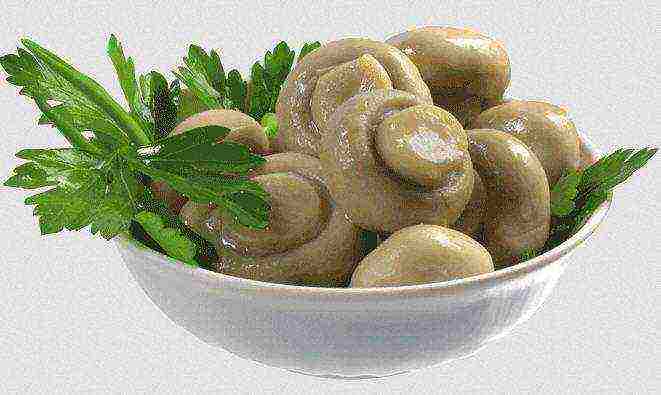
To get a rich harvest, you should properly care for the mushrooms. Pay attention to the temperature. Indoors, immediately after planting, it should be within 26 ° C. At this temperature, the mycelium grows well and quickly and gives a good harvest of mushrooms. If the temperature is higher, then the mycelium will grow in the surface layer and give a lower yield.
Watch for moisture as well. It should be around 60%. If the humidity is less, then the mycelium will begin to dry and grow worse. To prevent this, be sure to water with a garden sprayer. But do this carefully so that water does not penetrate into the manure mixture, otherwise it can damage the mycelium.
After about 10 days, the mycelium will grow well, the temperature should be reduced to 20 ° C. Cover the soil surface with earth. The soil must be used sod, it must be moist. Sift through a sieve before pouring. Do not seal it to give air to the mycelium.
Next, you just need to monitor the temperature - do not let it rise above 20 ° C, and the humidity - do not let it drop below 80%. You also need to regularly ventilate the room to get rid of carbon dioxide. The first fruits will appear 35 days after planting. Fruiting will last for three months.
Subject to all the rules, you can get a rich harvest, the sale of which will fully justify all the costs. You will also enjoy delicious dishes from champignons.
Discuss this article on the forum
- Ringed cap - edible mushrooms
- Real milk mushrooms - similar mushrooms
- Drying methods for mushrooms
- The healing effect of reishi mushroom
- Polish mushroom


